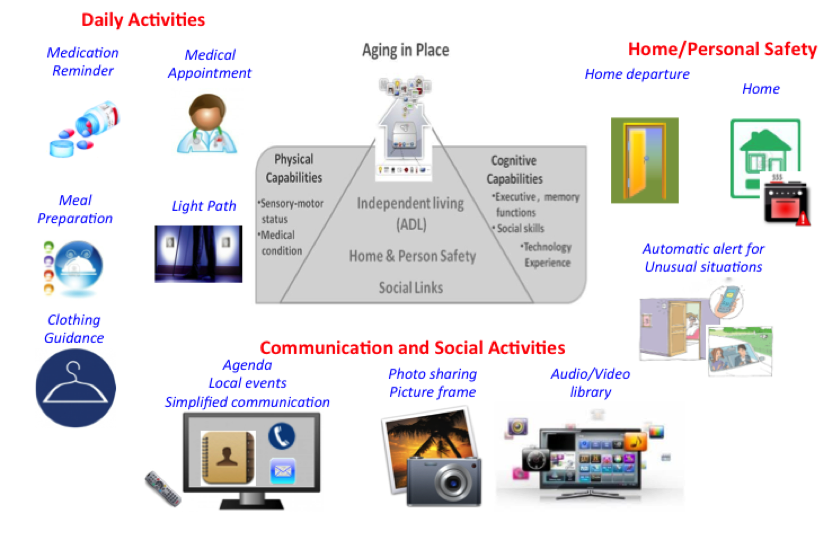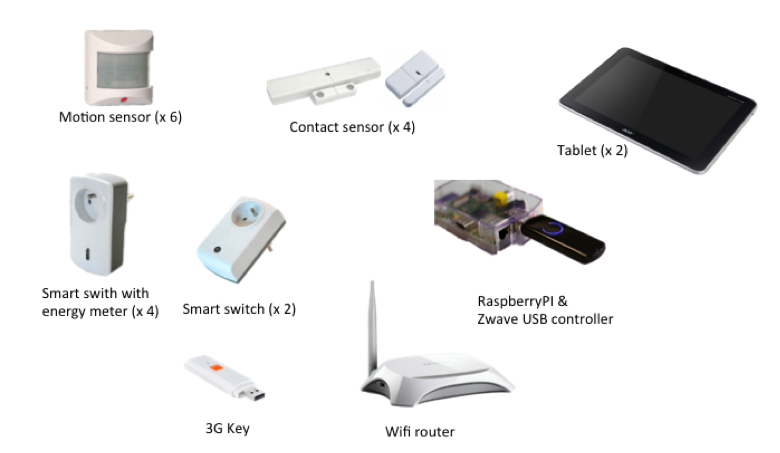Section: New Software and Platforms
HomeAssist: A Platform for Assistive Living
Participants : Charles Consel, Loïc Caroux [correspondent] , Thomas Freslon, Adrien Carteron, David Daney, Lucile Dupuy, Geoffrey Escojido, Bernard N'Kaoua, Hélène Sauzéon, Alexandre Spriet.
The HomeAssist platform proposes a systemic approach to introducing an assistive technological platform for older people. To do so, we formed a trans-disciplinary team that allows (1) to identify the user needs from a gerontological and psychological viewpoint; (2) to propose assistive applications designed by human factors and HCI experts, in collaboration with caregivers and users; (3) to develop and test applications by software engineers; (4) to conduct a field study for assessing the benefits of the platform and assistive applications, in collaboration with caregivers, by deploying the system at the actual home of elders.
The HomeAssist platform is implemented on top of the DiaSuiteBox platform, using a suite of tools, namely DiaSuite, that have been designed, developed and tested by our research group at Inria. The DiaSuite tools include a dedicated integrated development environment that enables applications to be developed quickly and safely. This technology has been successfully applied to a variety of domains where environments consist of networked objects that need to be orchestrated.
Applications
HomeAssist offers an online catalog of applications. Using this catalog, the user and the caregiver determine what and how activities should be assisted by selecting the appropriate assistive applications and configuring them with respect to the user’s requirements and preferences. The resulting set of applications forms a personalized assistive support. Additionally, to respond to evolving needs, our platform allows to stop/remove applications easily and to install new ones from the online catalog.
This platform proposes many applications in three domains of everyday life:
-
Daily activities: including activity monitoring, light path, and a reminder.
-
Home or personal safety: including entrance monitoring, stove monitoring, and warning if no movements are detected after a certain amount of time.
-
Communications and social activities: including collaborative games, videoconference, information about local events, TV programming, etc.
For video presentations of HomeAssist, see the following:
-
http://videotheque.inria.fr/videotheque/media/23705 . Title: “Dia Suite Box”. Produced in 2013.
-
http://videotheque.inria.fr/videotheque/media/29998 . Title: “DomAssist : L’assistance numérique à la personne”. Produced in 2014.
Devices
Several entities have been identified to deliver an assistive support. These entities include (1) technological devices: wireless sensors (motion detectors, contact sensors and smart electric switches), and two tablets, and (2) software services (agenda, address book, mail agent, and photo agent) to monitor everyday activities and propose assistive applications. Sensors are placed in relevant rooms in the house: kitchen, bedroom, bathroom, and around the entrance.
Experimental validation
A field study is currently being conducted with elderly people. The major purpose of this study is to identify the benefits of using HomeAssist for this population in an ecological framework. We selected 24 elderly people with different levels of autonomy (GIR scores). The HomeAssist technology has been installed in their house during 9 months. Twenty-four non-equipped elders were also selected to participate to the study, as control participants.
The expected impact of HomeAssist reflects the trans-disciplinary nature of the project. We aim to deliver results in the domain of (1) elderly care, (2) ergonomics and human factors, and (3) pervasive computing.
The major expected results are that HomeAssist (1) prolongs ageing in place, improves well-being of the users, and improves the efficiency of the caregiving environment; (2) is a cognitively low-cost assistive technology, and is well accepted and perceived as useful and usable by the users; (3) is technologically robust, and is a validated assistive platform
First results are expected in January 2015.
External Partners
The HomeAssist platform is being developed with support from the following partners:



